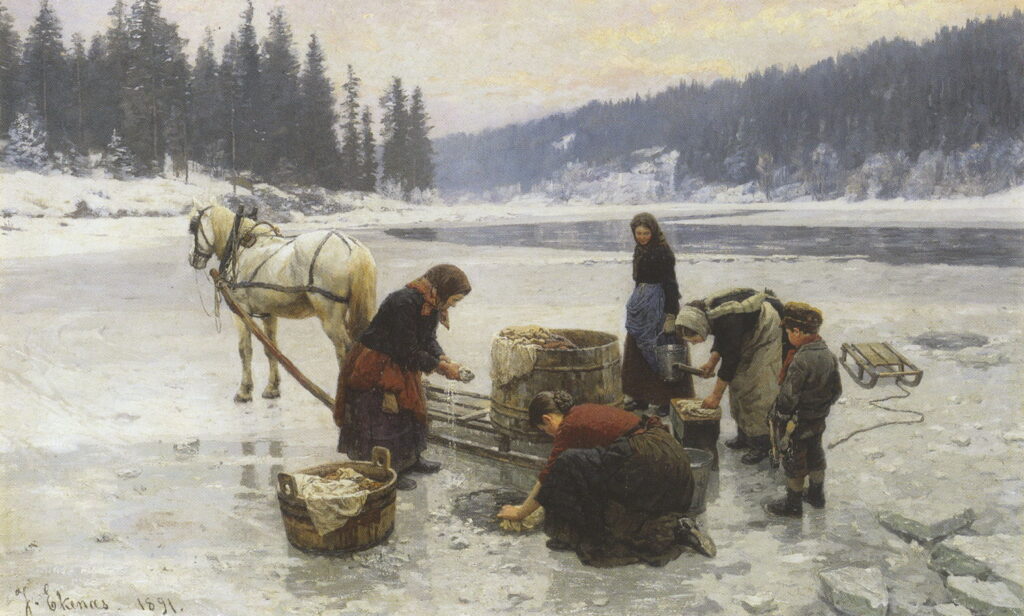Laundresses in a landscape 2

In the first of these two articles celebrating the work of generations of women who washed clothes and linen outdoors, and have been featured in landscape paintings, I covered the period up to the end of the 1870s, when Impressionism was at its height. This account resumes at about 1880, and moves on to the early twentieth century.
Alice Havers (1850–1890), Washerwomen (date not known), oil, dimensions not known, Walker Art Gallery, Liverpool, England. Wikimedia Commons.
Alice Havers’ Washerwomen, which given her tragically brief life must have been painted around 1880, shows a wide range of ages, working together, some repairing the clothes, others talking. On the other side of the river, the fruit trees are in blossom.
Eugène Boudin (1824–1898), Washerwomen by the River (c 1880-85), oil on panel, 26.2 × 36.2 cm, Israel Museum מוזיאון ישראל, Jerusalem, Israel. Wikimedia Commons.
Later in Eugène Boudin’s career he painted Washerwomen by the River (c 1880-85), above, and Laundresses on the Beach, Low Tide, Aval Cliff, Étretat (c 1890-94), below. The latter painting is remarkable for its rough facture, and for the number of women gathered by one of the most recognisable landmarks on the Normandy coast, the arch of Étretat.
Eugène Boudin (1824–1898), Laundresses on the Beach, Low Tide, Aval Cliff, Étretat (c 1890-94), oil on panel, 20.4 × 34.9 cm, location not known. Wikimedia Commons.
Charles Courtney Curran (1861–1942), A Breezy Day (1887), oil on canvas, 30.3 x 50.8 cm, Pennsylvania Academy of the Fine Arts, Philadelphia, PA. Wikimedia Commons.
Early in his career, the American artist Charles Courtney Curran painted a series of works showing young women at work outdoors, among which the most successful, A Breezy Day (1887) won the Third Hallgarten Prize for Oils from the National Academy of Design the following year.
Vincent van Gogh (1853-1890), The Langlois Bridge at Arles with Women Washing (1888), oil on canvas, 54 x 65 cm, Kröller-Müller Museum, Otterlo. WikiArt.
Painted when Vincent van Gogh was at Arles, one of his best-known groups of works includes The Langlois Bridge at Arles with Women Washing (1888). This is one of four oil paintings, a watercolour, and at least four drawings he made of this motif, with the aid of a perspective frame he had made for himself. This shows a traditional wooden drawbridge, one of several over the canal running from Arles to Bouc. Built in the early nineteenth century, it was sadly replaced by concrete in 1930.
Paul Gauguin (1848–1903), Washerwomen of Arles I (1888), oil on canvas, 75.9 x 92.1 cm, The Museum of Modern Art, New York, NY. Wikimedia Commons.
In the same year, Paul Gauguin painted a group of women hard at work near Arles in his Washerwomen of Arles I (1888).
Pierre-Auguste Renoir (1841–1919), The Laundress (1891), oil on canvas, 46 × 56 cm, Private collection. Wikimedia Commons.
Pierre-Auguste Renoir’s The Laundress (1891) sets a single, quite well-dressed woman doing her washing in one of his sumptuously soft-focus landscapes.
Jahn Ekenæs (1847–1920), Women Doing Laundry Through a Hole in the Ice (1891), oil on canvas, 67 × 108 cm, Private collection. Wikimedia Commons.
The Norwegian painter Jahn Ekenæs teaches us that, even in the bitter Nordic winters, the washing still had to be done: his Women Doing Laundry Through a Hole in the Ice (1891) seem to have the toughest job of all. Note that only one of them is wearing anything on her hands.
Peder Mørk Mønsted (1859–1941), Laundry Day (1899), oil on canvas, 24.5 × 16.5 cm, location not known. Wikimedia Commons.
Peder Mørk Mønsted’s Laundry Day (1899) shows kinder conditions during the summer, when doing the washing would surely have been a more popular task.
Manuel Garcia y Rodriguez (1863–1925), White and Black. Andalucian Landscape. Laundresses in the River Guadaíra (1903), further details not known. Wikimedia Commons.
In common with many of these paintings, Manuel Garcia y Rodriguez uses the white of the linen heightened in sunshine to generate contrast, in his White and Black. Andalucian Landscape. Laundresses in the River Guadaíra from 1903.
As indoor domestic water supplies became widespread during the twentieth century, washing clothing and linen in the countryside died out, and vanished from the landscape.




